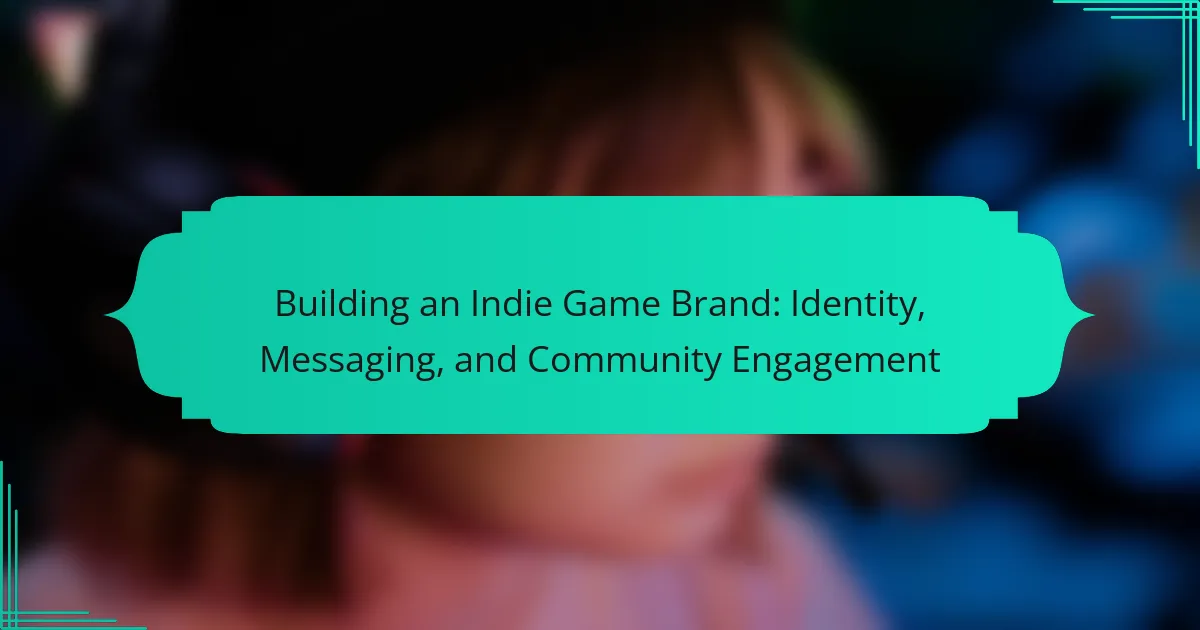Building a strong indie game brand is essential for standing out in a competitive market. This article explores creating a unique identity, developing consistent messaging, and fostering community engagement. It highlights the importance of visual elements, authentic storytelling, and player connections. Additionally, it addresses the challenges indie developers face in 2025, including budget constraints and evolving player expectations.

What are the essential components of an indie game brand identity?
An indie game brand identity consists of unique visual elements, consistent messaging, and community engagement strategies. Visual elements include logos, colour schemes, and art styles that reflect the game’s theme. Consistent messaging involves clear communication of the game’s values and narrative. Community engagement fosters a loyal player base through social media interactions, events, and feedback loops. Each component strengthens the overall brand identity and enhances player connection.
How does visual design influence brand perception?
Visual design significantly shapes brand perception by creating immediate emotional connections and establishing trust. A cohesive and appealing visual identity enhances recognition, making the brand more memorable. Effective design elements, such as colour schemes and typography, convey the brand’s values and personality, influencing consumer attitudes. For indie game brands, a unique visual style can differentiate from competitors, fostering a loyal community. Engaging visuals can also enhance user experience, leading to positive word-of-mouth and increased visibility in a crowded market.
Why is storytelling important for an indie game brand?
Storytelling is crucial for an indie game brand as it creates emotional connections with players. A compelling narrative enhances brand identity, making the game memorable. Engaging stories foster community involvement, encouraging players to share experiences and feedback. This interaction builds loyalty and strengthens the brand’s presence in a competitive market.
Which elements contribute to a memorable logo design?
A memorable logo design is achieved through simplicity, uniqueness, relevance, versatility, and timelessness. These elements ensure the logo effectively represents the indie game brand while engaging the target audience.
Simplicity allows for easy recognition and reproduction. A unique logo differentiates the brand from competitors. Relevance connects the logo to the game’s themes and audience. Versatility ensures the logo works across various platforms and sizes. Timelessness helps maintain brand identity over years, avoiding trends that may quickly fade.
How can colour psychology enhance brand recognition?
Colour psychology can significantly enhance brand recognition by influencing emotions and perceptions. Colours evoke specific feelings that can align with a brand’s identity, creating a memorable impression. For instance, blue often conveys trust, while red can evoke excitement.
Brands that strategically choose colours based on psychological principles can differentiate themselves in a crowded market. This unique attribute of colour selection can enhance user engagement and loyalty. A study found that colour increases brand recognition by up to 80%.
In indie game branding, consistent colour schemes across marketing materials can foster community engagement and identity. This rare approach helps build a cohesive brand narrative that resonates with players. Ultimately, leveraging colour psychology can create a strong visual identity that enhances brand recognition and fosters emotional connections.
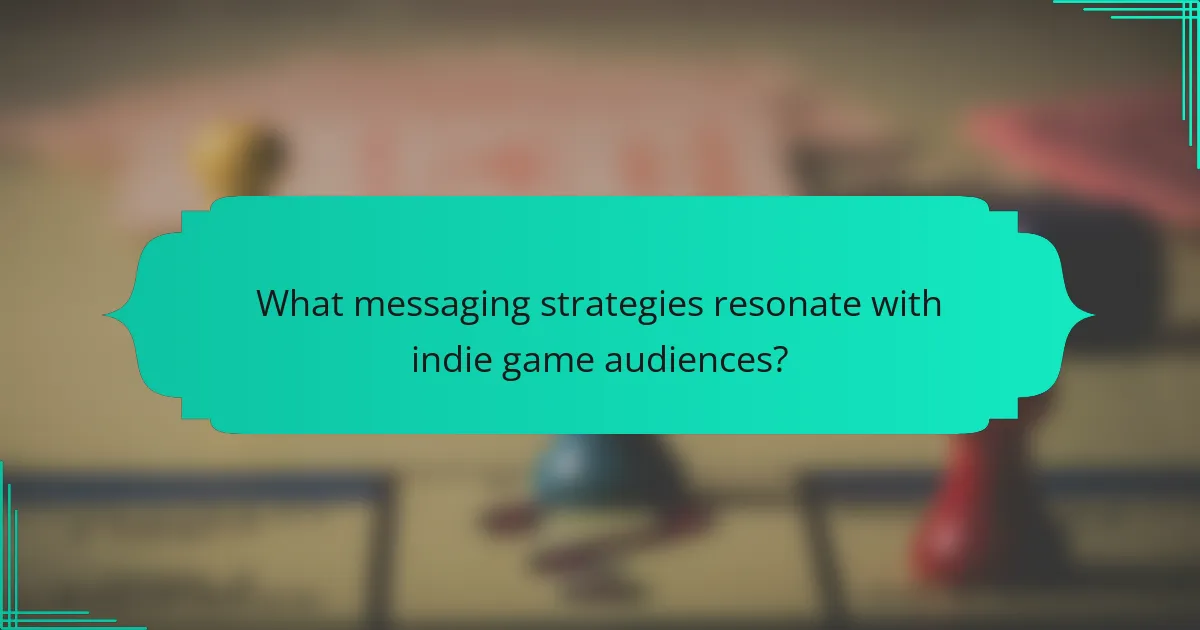
What messaging strategies resonate with indie game audiences?
Engaging indie game audiences requires authentic storytelling, community involvement, and consistent branding. Highlighting unique game features and fostering player connections enhances loyalty and interest. Gamers appreciate transparency and responsiveness, making regular updates and community feedback vital for successful messaging.
How can tone and voice reflect brand personality?
Tone and voice significantly shape a brand’s personality by conveying its values and emotions. Consistent tone fosters recognition and trust within the indie game community. For instance, a playful tone may reflect creativity, while a serious tone can demonstrate commitment to quality. Engaging with players through authentic communication enhances community connection, making the brand more relatable. This strategic alignment between tone, voice, and brand identity can ultimately drive loyalty and engagement.
Why should messaging be tailored for different platforms?
Messaging should be tailored for different platforms to effectively reach and engage diverse audiences. Each platform has unique characteristics and user expectations that influence communication style. For example, Twitter favours concise and witty messages, while Instagram thrives on visual storytelling. Tailoring messaging enhances brand identity, ensuring consistency across channels while resonating with specific user demographics. This approach fosters community engagement and strengthens brand loyalty.
Which key messages should be prioritized for engagement?
Prioritize authenticity, community connection, and unique storytelling in your engagement messages. These elements foster trust and loyalty among players. Highlight the game’s unique attributes, such as innovative gameplay mechanics or art style, to differentiate your brand. Emphasize player feedback and involvement in the development process to build a strong community. Regular updates and transparent communication reinforce engagement and keep your audience invested.
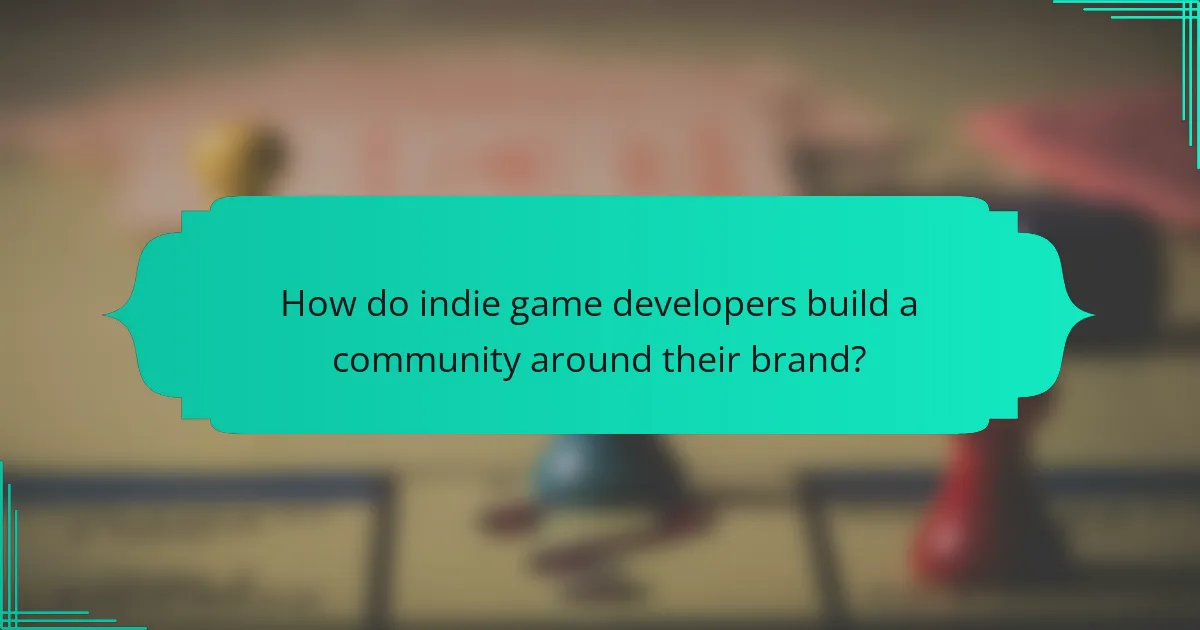
How do indie game developers build a community around their brand?
Indie game developers build a community around their brand by fostering engagement, sharing authentic messaging, and creating a unique identity. They utilize social media platforms, forums, and community events to connect with players. Developers often share behind-the-scenes content, updates, and personal stories to build trust and loyalty. Engaging with feedback and involving the community in the development process enhances a sense of ownership among players. This approach leads to a vibrant community that supports the brand and contributes to its growth.
What role do social media platforms play in community engagement?
Social media platforms are crucial for community engagement in indie game branding. They facilitate direct communication between developers and players, fostering relationships and feedback. Engaging content, such as behind-the-scenes updates or interactive polls, enhances community involvement. Platforms like Twitter and Discord allow real-time interaction, creating a sense of belonging among players. Additionally, user-generated content can amplify brand visibility and authenticity.
How can developers foster meaningful interactions with players?
Developers can foster meaningful interactions with players by prioritising community engagement and authentic messaging. Building a strong indie game brand involves creating a relatable identity that resonates with players. Regularly engaging with the community through social media, forums, and live events helps establish trust and loyalty. Providing transparent updates and responding to player feedback enhances the connection. Unique attributes like personalised experiences or in-game events can further deepen these interactions, making players feel valued and involved in the game’s evolution.
What are effective methods for gathering player feedback?
Effective methods for gathering player feedback include surveys, beta testing, community forums, and social media engagement. These strategies foster direct communication with players and enhance game development. Surveys can quantify player preferences, while beta testing provides firsthand insights into gameplay experiences. Community forums allow for open discussions, and social media can facilitate real-time feedback. Engaging players in these ways strengthens the indie game brand and builds a loyal community.
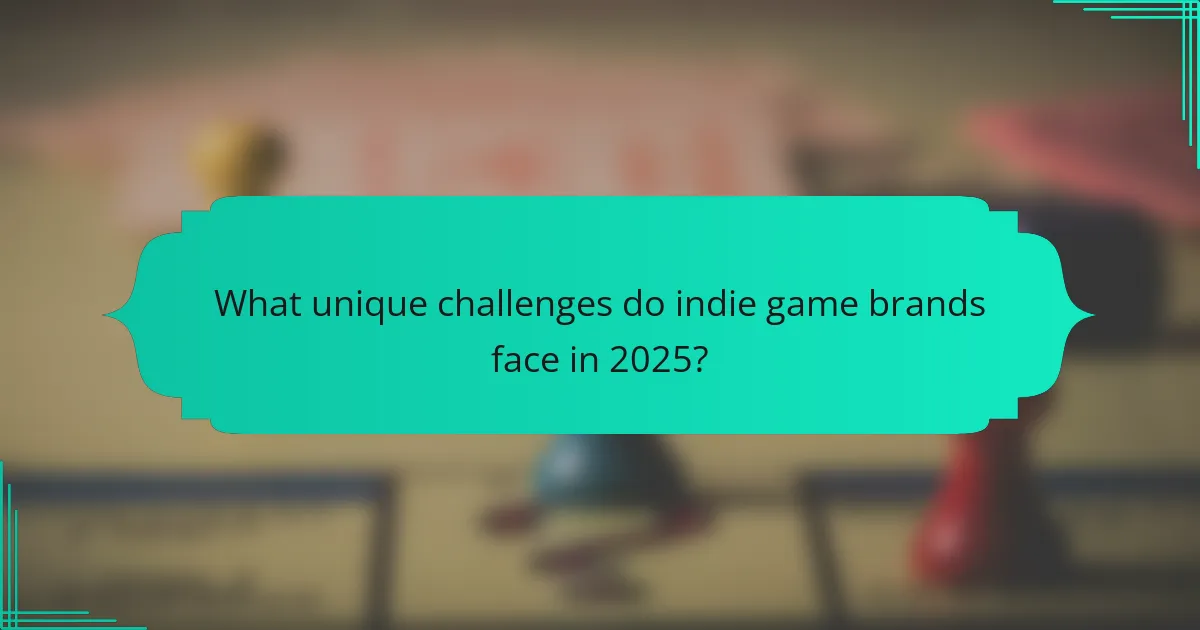
What unique challenges do indie game brands face in 2025?
Indie game brands in 2025 face unique challenges including intense competition, limited marketing budgets, and evolving player expectations. These factors complicate brand identity and community engagement efforts.
Competition is fierce as numerous indie titles flood the market, making differentiation essential. Limited budgets restrict access to professional marketing resources, impacting visibility. Additionally, players increasingly demand innovative gameplay and unique narratives, pressuring indie developers to meet high standards.
Community engagement poses another challenge. Building a loyal fan base requires consistent interaction and responsiveness, which can be resource-intensive for small teams. Establishing a strong online presence through social media and community platforms is crucial but time-consuming.
In summary, indie game brands must navigate a complex landscape characterised by competition, budget constraints, and the need for active community engagement to succeed in 2025.
How does competition with larger studios impact indie branding?
Competition with larger studios often challenges indie branding by necessitating unique identities and strong community engagement. Indie developers must differentiate through innovative messaging and authentic narratives. This creates a loyal community that values originality over mainstream appeal. As a result, successful indie brands leverage their unique attributes, such as personal stories and niche gameplay experiences, to attract dedicated players.
What strategies can indie developers use to stand out?
Indie developers can stand out by cultivating a strong brand identity, crafting clear messaging, and engaging deeply with their community. Establishing a unique visual style and narrative helps create memorable experiences. Consistent communication through social media and platforms builds trust and loyalty. Hosting events or participating in game jams fosters connections and showcases creativity.
How can funding limitations affect brand development?
Funding limitations can significantly hinder brand development for indie games. Limited resources restrict marketing efforts, community engagement, and identity establishment. This can lead to poor visibility and reduced audience connection. As a result, indie developers may struggle to create a strong brand presence, impacting their overall success.
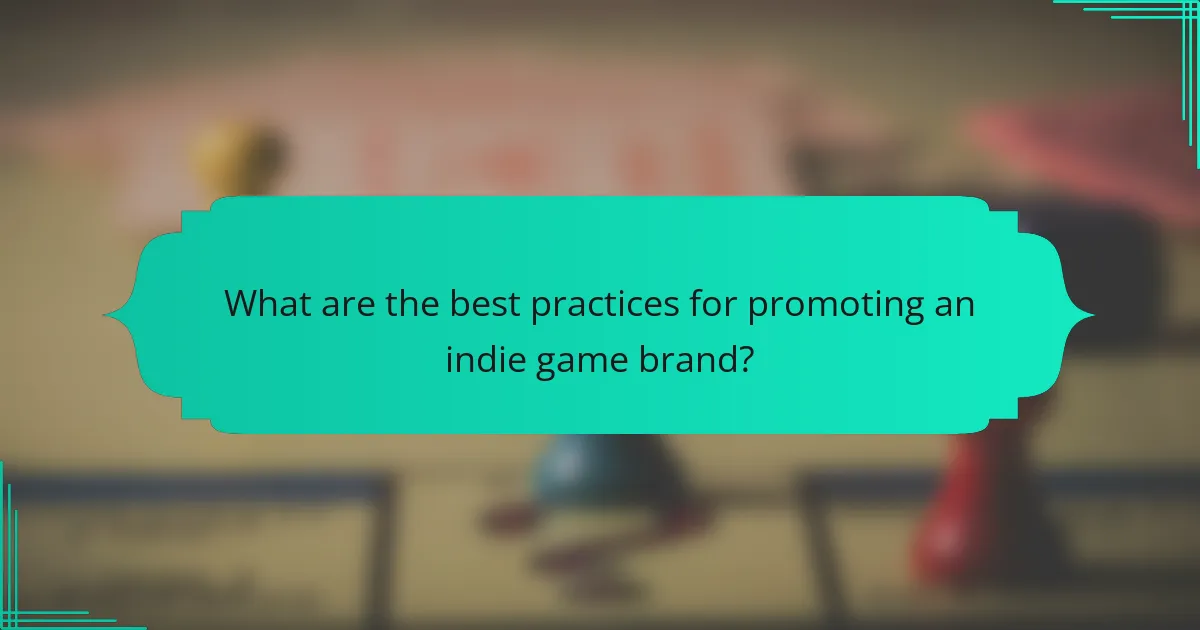
What are the best practices for promoting an indie game brand?
To effectively promote an indie game brand, focus on identity, messaging, and community engagement. Establish a clear brand identity that reflects the game’s unique attributes. Create consistent messaging across platforms to build recognition. Engage with the community through social media, forums, and events to foster loyalty and word-of-mouth promotion. Utilize feedback to adapt and improve the brand experience.
How can partnerships enhance brand visibility?
Partnerships can significantly enhance brand visibility by leveraging shared audiences and resources. Collaborating with other brands or influencers allows indie game developers to tap into established communities. This increases exposure and fosters credibility. For instance, cross-promotional campaigns can reach diverse demographics, amplifying marketing efforts. Engaging with partners can also lead to unique content and events that attract attention, driving player interest and community growth.
What are the most effective marketing channels for indie games?
The most effective marketing channels for indie games include social media, influencer partnerships, gaming forums, and crowdfunding platforms. These channels enhance brand visibility and community engagement.
Social media platforms like Twitter and Instagram allow indie developers to share updates and connect with players. Influencer partnerships can amplify reach through trusted voices in the gaming community. Gaming forums provide direct interaction with enthusiasts, fostering a loyal community. Crowdfunding platforms not only raise funds but also build anticipation and investment in the game’s success.
Utilising a combination of these channels can lead to a stronger indie game brand presence and increased player engagement.
Which common mistakes should be avoided in brand promotion?
To effectively promote an indie game brand, avoid common mistakes that can hinder growth. Misalignment between brand identity and messaging can confuse potential players. Neglecting community engagement limits feedback and loyalty. Overlooking market research may lead to ineffective strategies. Failing to maintain consistent branding can damage recognition. Ignoring analytics prevents optimisation of promotional efforts. Lastly, underestimating the power of storytelling can weaken emotional connections with the audience.
What strategies can optimise community engagement and retention?
To optimise community engagement and retention, focus on creating meaningful interactions. Foster a sense of belonging through regular communication and feedback loops.
Encourage user-generated content to build investment in the brand. Host events and competitions to maintain excitement and involvement. Utilise social media to share updates and celebrate community milestones.
Implement loyalty programmes to reward active participants, enhancing their commitment. Analyse engagement metrics to tailor strategies effectively, ensuring alignment with community interests.
